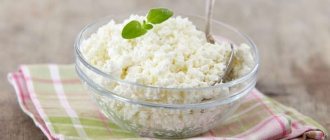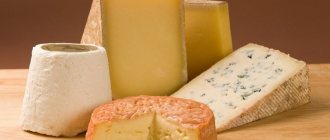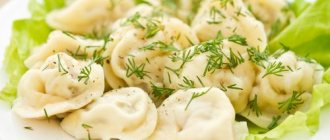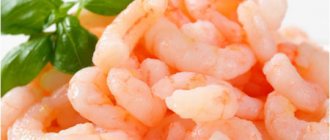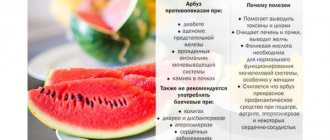Cottage cheese and pancreatitis of the pancreas
Inflammation of the pancreas is a dangerous disease that poses a serious threat to the entire body as a whole. In the presence of this pathological process, the enzymes produced by the organ stop being released into the duodenum; instead, they are activated in the gland itself, which inevitably leads to self-digestion. In the first few days, the aggravated inflammatory process must be treated in a hospital, where the patient will receive the most necessary medical care.
Success on the path to recovery is ensured not only by therapeutic measures, but also by a special diet (table No. 5), which excludes from the patient’s menu foods that can harm his body. A person suffering from pancreatitis should adhere to this diet immediately after the three-day fast at the first stage of the disease ends. Next, you can gradually introduce porridges and soups, lean steamed meats, fish, boiled eggs and vegetables, as well as sour cream, kefir and yogurt into the diet.
Doctors unanimously advise paying special attention to cottage cheese. This fact is explained by the easy digestibility of the product, which is extremely important in the presence of a disease such as pancreatitis. It is known that the proteins that cottage cheese is rich in have the ability to be digested much easier and faster than the proteins contained in meat. And since the body is weakened, the first task that needs to be completed is to saturate it with proteins, fats and amino acids as soon as possible.
When trying to improve your health, it is worth remembering that in this situation not any cottage cheese is suitable for consumption. This is exactly what will be discussed further.
Features of the consumption of dairy products at different stages of the disease
Depending on the characteristics of the disease, patients' diet should be adjusted. Most products that are allowed during the remission stage can cause significant harm to health during an exacerbation.
Acute phase of pancreatitis
With the first appearance of an attack of pancreatitis, you must immediately exclude all dairy products from your diet. Only from 2-3 days can you introduce milk porridge in liquid form into the menu. It should be prepared with milk 1 or 2.5% fat or diluted with water in proportions 1 to 1.
A week after an exacerbation, you can eat a small amount of low-fat cottage cheese. Product intake starts at 50 g. After a week, the daily norm is 100 grams. You can cook a steam omelet with diluted milk.
If positive dynamics are observed, then kefir can be introduced into the diet. It should be consumed gradually, also starting with 50 grams on the first day. You can increase the amount of kefir consumed to 100 grams in a week.
You can add a small amount of butter (butter or vegetable oil up to 5 grams per day) to vegetable or fruit purees. If a person has pancreatitis, then he should adhere to this diet until remission is achieved. This takes approximately 2 months.
Chronic phase of pancreatitis
A few months after the exacerbation of this disease, with the onset of a stable phase of remission, the menu of people with inflammation becomes more extensive.
Milk is also used only in diluted form for the preparation of:
- Jelly, omelettes;
- Porridge and first courses.
The daily consumption of butter increases to ten grams. Cottage cheese and kefir are retained in the diet, but with a small percentage of fat content. Kefir can be replaced with another dairy product, but you need to ensure that their fat content does not exceed 2.5%.
As symptoms subside, foods such as:
Ryazhenka; Yogurts. Most patients are interested in the question: is it possible to consume yogurt for pancreatitis, and in what form? You can drink yogurt, but no more than one glass per day
Additionally, it is also important to consider what additives it contains.
After the permission of the attending physician, dairy drinks with sweeteners such as:
- Sweetener;
- Honey;
- Puree made from berries and fruits.
The menu also includes products such as cream and sour cream, but their fat content should not exceed 10%
It is important to note that they can be consumed no more than every other day and no more than one tablespoon.
Useful properties and composition of cottage cheese
Cottage cheese is a popular fermented milk product that is a rich source of protein. It contains vitamins A, C, P, D, E, group B, including folic acid (B9). The composition contains calcium, phosphorus and iron necessary for the body.
All components of cottage cheese are in an ideal combination, which allows the product to be well absorbed.
Cottage cheese is a product with a low glycemic index (the rate of impact on blood glucose levels). It comes in varying degrees of fat content. The higher it is, the higher the calorie content.
Cottage cheese is allowed for pancreatitis, but you should remember the peculiarities of using the product at different stages of the disease
Glycemic index, calorie content and BJU ratio - table
| Cottage cheese, fat content | Glycemic index (GI) | Calorie content (per 100 g) | Proteins, % | Fats, % | Carbohydrates, % |
| Fat, 18% | 30 | 250 | 14 | 18 | 2,9 |
| Bold, 9% | 25 | 180 | 16 | 9 | 2 |
| Low fat, 0.6% | 15 | 88 | 18 | 0,6 | 1,5 |
Cottage cheese and products made from it are included in the diet menu for many diseases. It is also useful for pancreatitis - inflammation of the pancreas. In such a situation, the body needs protein. Therefore, it is especially recommended for people with this diagnosis. And there are reasons for this:
- inhibits or stops inflammation;
- reduces the risk of complications;
- helps strengthen the immune system;
- stimulates the production of a special enzyme responsible for protein breakdown.
Lecithin, which is part of cottage cheese, helps remove harmful cholesterol from the body.
With pancreatitis, patients are advised to choose food that requires a minimum of energy for processing. Little effort is spent on digesting cottage cheese, and in return the body receives a lot of useful substances.
Making cottage cheese is a very simple process. When the starter is added, the milk gradually ferments and over time takes the form of cottage cheese. After pressing (separating the finished product from the whey), the cottage cheese can be eaten. The fermented milk product is primarily famous for its high content of easily digestible protein. The finished product comes in three types of fat content:
- Low fat (0% fat);
- Bold (0.5%-3%);
- Fatty (more than 3% fat).
Many people are mistaken, thinking that the lower the percentage of fat content, the less benefit there is in the cottage cheese. This is not true at all: the amount of protein and calcium is not affected by the percentage of animal fats. When treating the pancreas, doctors recommend eating low-fat or low-fat cottage cheese.
100 grams of cottage cheese contains:
- 22.0 g proteins;
- 3.3 g carbohydrates;
- 0.7 g fat;
- 105 kcal.
The average daily consumption of cottage cheese in its pure form or in dishes prepared from it should not exceed 250 grams.
Features of use
If you buy a fermented milk product in a store, pay attention to its composition and expiration date. Curd products (cheeses, candy bars), and in some cases the product itself can be stored for more than 10 days. In this case, preservatives are added to them, which should be avoided in case of pancreatitis. Store-bought products may contain palm oil, dyes, and citric acid, which negatively affect the pancreas.
When buying cottage cheese, a person with pancreatitis should pay attention to its fat content. It should not exceed 3-9%.
The shelf life of a good fermented milk product is 3 days, only then is the product natural and healthy. If you decide to purchase a fermented milk product at the market or from friends, pay attention to the smell and taste of the cottage cheese; they should not be sour. When buying goods from strangers, do not eat them raw, but rather prepare cheesecakes.
Depending on what stage of pancreatitis the patient has (acute or chronic), whether the inflammation is complicated by diseases of other organs or not, the dairy product is eaten and prepared differently.
In acute form
In acute pancreatitis, cottage cheese is introduced into a person’s menu 2-3 days after the end of the attack and therapeutic fasting. The dairy product should enter the human body either raw (mashed through a sieve) or in the form of steamed pudding. During this period, the patient is allowed to consume cottage cheese with a fat content of no more than 1-1.5%. You can eat it 3 times a week, 200 g per day.
If the body lacks calcium, then a product rich in it can be prepared at home from skim milk and calcium lactic acid purchased at the pharmacy.
Place a pan of milk on the burner, heat it and add calcium. Curd clots soon appear on the surface of the milk. The dishes are removed from the heat and the mixture is filtered. The calcined product is ready.
In the acute form of pancreatitis, consumption of fermented milk products increases immunity, reduces inflammation of the gland and prevents the development of complications.
In the chronic stage
When the disease enters the chronic stage, cottage cheese continues to be present in the diet menu. At this time, you can already eat various cottage cheese dishes: casseroles, soufflés, pastas. Low-fat sour cream, sweet berries, honey and dried fruits, cereals and meat are added to recipes. The fat content of the product is also increased to 9%, and its quantity to 250-280 g per day.
During remission
During the period of remission, lazy dumplings are prepared from cottage cheese, and are also used as a filling for savory pastries. The daily intake of the product is not increased and is still eaten no more than 3 times a week. With stable remission, the fat content of the product can be 10-12%, but in some people this can provoke an exacerbation of the disease.
Cholecystopancreatitis
Cottage cheese is a mandatory component of the menu for cholecystopancreatitis (simultaneous inflammation of the gallbladder and pancreas). In the acute form, after therapeutic fasting, eat a low-fat product (up to 3%); during the period of remission, dairy products (casseroles, dumplings) can have a fat content of up to 9%.
For pancreatitis and gastritis
The beneficial properties of cottage cheese make it possible to include it in the diet for gastritis that occurs simultaneously with pancreatitis. 48 hours after the attack is relieved in an acute form of gastric disease, this low-fat, unleavened ingredient is introduced into the menu as part of puddings and cheesecakes. The dishes should be eaten for second breakfast (at 9:30 -10:00), because... At this time, cottage cheese is better absorbed in the stomach, without causing discomfort.
During the chronic stage of gastritis, the stomach secretes a lot or little hydrochloric acid, so sudden exacerbations may occur.
Before eating fermented milk products during this period, you should consult your doctor. Sometimes fresh cottage cheese is excluded from the patient’s diet (in case of high acidity); only casserole or steam soufflé are allowed. For gastritis with low acidity, you can eat small quantities of all dishes made from this product, including pasta.
Is cottage cheese allowed for pancreatitis?
In order to prevent an increase in gastric secretion and thereby not lead to the development of complications, patients with pancreatitis should know some rules regarding the use of cottage cheese. They boil down to a few simple points:
- Preference should be given to a low-fat product;
- With the onset of remission, you can switch to taking low-fat cottage cheese (up to 3%);
- The acidity of the product should not be more than 170 units on the Turner scale;
- Cottage cheese can only be consumed in pure pureed form; steam pudding or casserole is perfect as an alternative;
- It is not allowed to eat this product every day; 2-3 doses a week are enough, while the optimal daily dose should be about 200-300 g.
Only if these recommendations are followed will the use of cottage cheese be beneficial and speed up the healing process, redirecting the disease into remission.
Diet for acute pancreatitis
During the period of exacerbation of the pathology, the patient develops severe pain and has no desire to eat. The patient's health deteriorates significantly. During the first 3–5 days, therapeutic fasting is recommended. During this period, the patient can only drink. It should be water without gas.
After the pain subsides, the menu can include vegetables crushed to a puree, soups thickened with cereals - they need to be cooked only in water, vegetable broths without salt and spices. When cooking soups, you can use oatmeal or buckwheat. During an exacerbation, you should not eat millet, egg and corn grits. In chronic diseases, these types of cereals should be limited as much as possible.
As the condition stabilizes, the menu can be expanded to include boiled veal and chicken. The patient begins to be served oatmeal cooked in water and mashed potatoes. Before serving, it is diluted with broth to form a puree soup. Salting and adding milk to these dishes is strictly prohibited.
After 14 days from the onset of the attack, the diet may include low-fat dairy products. The best choice would be milk or kefir. Cottage cheese is allowed, but in limited quantities. Porridge can now be cooked with milk diluted with water. You can eat steamed vegetables. A decoction of rose hips is served as a drink.
If unpleasant symptoms appear - nausea, vomiting, pain - you must immediately exclude the foods that caused the disease to worsen. 2 months after the exacerbation, the patient is prescribed a special dietary food - table No. 5P. It is typically low in fat and carbohydrates. Meals should be fractional up to 6 times a day.
Sample diet menu No. 5
A few words about the harm and benefits
Experts in the field of gastroenterology believe that cottage cheese must be present in the diet of people suffering from pancreatitis. The benefits of this product are undeniable, since it has the maximum beneficial effect on the entire body as a whole:
- Stops further development of the inflammatory process;
- Strengthens the immune system;
- Prevents the occurrence of complications;
- Promotes the removal of cholesterol due to the content of lecithin in the composition;
- Increases the production of protease inhibitors, whose main task is to break down protein.
In addition, cottage cheese contains a sufficient concentration of a whole range of vitamins (A, E, C, D, P, B vitamins), as well as vital minerals such as calcium and magnesium, potassium and iron, fluorine and phosphorus, sodium and sulfur .
Despite the advantages of the product, we should not forget about the possible harm that can be caused to one’s own health if one neglects important advice on eating cottage cheese. A patient with pancreatitis needs to remember: a low-fat or low-fat product, a limited dosage and the correct form of preparation are the key to success in the fight against inflammation of the pancreas.
Video on the topic:
Recommendations for selection and storage
One of the main dangers of cottage cheese is the rapid development of E. coli in it . If it enters the body, poisoning or an infectious intestinal disease occurs. Therefore, it is imperative to pay attention not only to the expiration date, but also to the color, smell, and appearance. Failure to comply with storage conditions can quickly compromise quality.
If the product storage rules are not followed, there is a risk of E. coli developing in the cottage cheese.
The most natural product without preservatives has a minimum shelf life . If periods of more than a week are indicated, then the amount of impurities is large. It is better to avoid such fermented milk products altogether.
You need to store cottage cheese in the refrigerator, it is better to avoid polyethylene. An enamel container is perfect. The ideal option is to buy only enough to eat in one day.
It is believed that the most natural cottage cheese is sold in markets. However, you will not be able to check its quality and freshness. It’s best to cook it yourself, especially since it’s not at all difficult to do. You need to boil 1 liter of milk on the stove. Remove from heat and add 0.5 liters of low-fat kefir and cool. After the curd has separated, you should filter the mass through cheesecloth. The quality of such a product will not be in doubt.
By preparing cottage cheese yourself, you don’t have to worry about the quality of the product.
Homemade cottage cheese - video
Rules for using the product
In order for cottage cheese to bring only benefits, it must be consumed wisely. People diagnosed with pancreatitis can eat it as a separate dish or prepare a variety of desserts from it.
During exacerbations of the chronic form and acute pancreatitis, it is better to switch to low-fat (0.6%). If the inflammation has subsided and there are no digestive disorders (nausea, diarrhea), it is possible to eat cottage cheese with a fat content of up to 5%. During the period of remission, it is allowed to consume a semi-fat product (9%). In case of stable remission, the fat content is increased with caution to 18%.
It is worth taking into account the following recommendations:
- The best choice for pancreatitis would be cottage cheese with a fat content of 3%, which is served grated.
- The combination of a raw product with milk is undesirable - this will cause additional irritation of the pancreas.
- The daily norm in its pure form is 200 g, no more than three times a week. No more than 100 g is allowed at one time.
The best time to eat cottage cheese is between other meals (second breakfast, afternoon snack). It is better to avoid the product in the evening, as it will be difficult for the pancreas to digest food at night.
During remission, it is allowed to mix with cereals, pasta, eat it in the form of lazy dumplings, or as a filling in savory baked goods.
Give up the habit of generously sprinkling cottage cheese with sugar or jam. Many fresh fruits are also included with caution for pancreatitis.
The product should not activate gastric and pancreatic secretions. Acidity - no more than 170 units. according to the Turner scale.
You can actively include souffles, casseroles, and puddings in your daily menu. They are allowed to be consumed immediately after breaking the fast. A little later, they begin to add greens, low-fat sour cream and vegetables. If the patient has a calcium deficiency, switch to calcined cottage cheese or additionally supply the product with this substance.
Rules of use
In order to ensure that after a sick person takes natural cottage cheese or any dish prepared from it, his general condition does not deteriorate, one should know the immutable features of consuming this fermented milk product during the progression of pancreatitis. They are as follows:
- to eliminate the factor of increasing the load on the digestive organs, this product is introduced into the daily menu only with low, no more than 1.5%, fat content;
- the acidity of cottage cheese consumed by a sick person should not exceed 170 units on the Turner scale;
- before eating this product in its natural form, it should be thoroughly ground, and also a small amount of low-fat sour cream and a teaspoon of honey should be added to it;
- When preparing dishes from cottage cheese, only cooking methods such as boiling in water, cooking with steam or baking without a golden brown crust in the oven are used.
People with pancreatic problems should remember that when it becomes inflamed, experts recommend consuming cottage cheese prepared independently at home. The recipe is quite simple, so anyone can cook it.
NATALIA LUKINA: “How did I manage to defeat pancreatitis at home in 1 week, spending 30 minutes a day?!” Read more >>
Use for pancreatitis
The acute form of pancreatitis is an extremely serious pathological process when inflammation and necrosis of pancreatic cells occurs. In the first days of the disease, the patient is subject to mandatory hospitalization in a surgical hospital with a fasting diet. At the end of fasting, protein foods that are easily digestible are gradually introduced in small quantities. In this sense, cottage cheese is considered an excellent product. Regular consumption of cottage cheese increases the body's immune defense and prevents complications.
The product can be eaten in its pure form. It is allowed to cook other healthy and incredibly tasty dishes. For pancreatitis, you can eat it in the form of pudding or cottage cheese casserole, soufflé or cottage cheese dessert. It is useful to eat dietary low-fat cottage cheese for breakfast with the addition of berries or dried fruits. It is not forbidden to add a spoonful of honey.
If the patient is not a fan of sweets, sprinkle the dish with herbs and add low-fat sour cream. When buying cottage cheese in a store, make sure that the fat content does not exceed 3 percent. Fatty varieties of the product are not recommended for consumption with pancreatitis.
Use for acute pancreatitis
In the acute stage, on days 4-5, it is allowed to consume cottage cheese in small portions. Introduce into the diet only with the permission of a doctor. To avoid irritation of the gastric mucosa, it is not recommended to combine cottage cheese with milk.
In case of acute pancreatitis, special requirements are imposed on the food product consumed. A dish that does not meet the specified parameters will provoke an exacerbation in the patient. Cottage cheese must be consumed fresh, not sour. When rated on the Turner scale, the product should not exceed 170 units. In the acute phase of the disease, cottage cheese is eaten three times a week. During the day it is permissible to eat 300 grams of the product.
To replenish calcium deficiency in the body, prepare special calcined cottage cheese by making it yourself at home. It is better to eat not a fresh version of the dish, but a thermally processed one, for example, in the form of a cottage cheese casserole or pudding.
It is useful in the first days to eat cottage cheese soufflé or pudding, a sweet curd mass. As the condition improves, the doctor allows a gradual increase in fat content to 5 percent. Later it is permissible to include the product in food daily. Then introduce salted cottage cheese products into your diet.
Chronic pancreatitis
If chronic pancreatitis worsens on the first day, the doctor prescribes therapeutic fasting for the patient. With the onset of improvement, protein-rich foods are gradually introduced into the diet. Cottage cheese becomes simply irreplaceable. If the patient does not experience diarrhea or heartburn from cottage cheese, it is allowed to gradually increase the fat content level.
From the beginning of the subsidence of the disease, the patient is allowed to gradually switch to consuming cottage cheese with a higher percentage of fat content (for example, 4-5%). This is possible if the period of remission is persistently maintained, when the patient stops complaining of nausea, vomiting or diarrhea. In addition, people with chronic pancreatitis are allowed to introduce the product into their diet not only in its pure form, but also dishes prepared on its basis.
We are talking about various cottage cheese casseroles (apple, pumpkin, carrot), puddings and soufflés (with banana or cereal), dumplings or flour products with cottage cheese filling. Over time, you can eat a fattier product, but do not forget that you cannot abuse, for example, 20% cottage cheese, because fatty cottage cheese slows down the absorption of calcium, which is why the entire digestive system begins to experience excessive stress.
Often chronic pancreatitis does not develop as an independent primary inflammatory disease, but as a complication of a number of other pathologies of the digestive tract. Gastritis, cholecystitis, and peptic ulcers of the stomach and duodenum can provoke the development of chronic pancreatitis. For these diseases, it is recommended to introduce cottage cheese and dishes with its addition into the mandatory diet. Cottage cheese is allowed to be eaten together with lean meats, boiled vegetables, and vegetable broths.
Cottage cheese and dishes with it are useful during the recovery period for stomach ulcers. The product is rich in calcium and vitamins of various groups.
Cottage cheese for exacerbation of pancreatitis
When a disease occurs for the first time under the influence of drug therapy, it tends to subside, however, for a number of reasons, the inflammatory process can manifest itself again from time to time. During such periods, it is also important to follow the doctor’s recommendations regarding abstaining from food in the first 3 days while maintaining the subsequent diet. An exacerbation of the disease is a relapse of the initially developed acute inflammatory process, therefore, the use of cottage cheese at this stage should be carried out in accordance with the above rules.
Many people who have once encountered such a problem as pancreatitis know that cottage cheese is simply an irreplaceable food for them. By following the advice of medical specialists on the rules for using this product, you can forget about your existing disease for a long time.
Video on the topic:
Consumption
The acute course of the disease is a serious pathogenic process in which cell death and inflammation of the pancreas occurs. On the first day of illness, the patient requires hospitalization in the surgery department, treatment is carried out with the help of a hunger strike.
On the way out of a starvation diet, slowly include protein foods in small amounts, which are easily digestible. One of the frequently asked questions from patients about nutrition is, is it possible to eat cottage cheese if you have pancreatitis? Cottage cheese is allowed because it is rich in proteins, minerals and vitamins.
With regular use, immunity increases, the production of protease inhibitors increases, the formation of inflammation is limited, the level of low-quality cholesterol decreases, and the product also prevents the development of complications.
Patients who have problems with the pancreas know that homemade cottage cheese is suitable for consumption during inflammation.
To eliminate the factor of increasing the load on the digestive organs, curd mass with low fat content, low-fat or low-fat, is introduced into the diet of patients. Fat content does not exceed 1.5%.
Taking cottage cheese for pancreatitis is acceptable in its pure form. It is allowed to make various fruitful and tasty dishes.
- Pudding.
- Cottage cheese casserole.
- Souffle.
- Dessert made from curd mass.
In the morning, it is recommended to eat dietary cottage cheese with minimal fat content, adding dried fruits or berries. It is allowed to add honey.
If the patient does not eat sweets, sprinkle the product with dill, parsley, and add low-fat sour cream. When purchasing curd mass in a store, it is important that the fat content does not exceed 3%. Products with high fat content should not be consumed if you have pancreatitis.
How to choose a quality product
It is not recommended to make home-made purchases, since at home it is not possible to follow all the rules for making cottage cheese, as in production. This is due to the fact that dairy products are an excellent environment for the life of various bacteria, so home-made cottage cheese often acts as the primary source of intestinal infections that provoke severe exacerbations of pancreatic disease.
Before purchasing a curd product in a supermarket, you must carefully study all the information on the packaging, namely, pay attention to the timing of the sale of the product, as well as the percentage of fat content of the product.
If the sale date is missing or cannot be read, then it is better to refuse to purchase such products.
If cottage cheese is purchased for a child, then you need to be especially vigilant with the production date and expiration date. It is also worth noting that children's cottage cheese and cottage cheese for adult nutrition have different preparation technologies. The main differences lie in the high standards for making children's cottage cheese:
- curd for baby food is prepared under complete aseptic conditions;
- special starters are used;
- milk goes through a filtration stage through specific membranes that ensure the removal of harmful components and the retention of protein molecules and calcium ions.
Baby food is an easily digestible product, since calcium elements are in ionized form. Such products are equally useful for both adults and children, especially with pancreatic damage to the pancreas, provided that the expiration date is observed.
Cottage cheese should be stored for no more than three days at a temperature of no more than 8 degrees. To optimally preserve the quality of the curd product, it is recommended to add a couple of pieces of refined sugar to it.
Prohibited dairy products
There is a list of dairy products that are strictly prohibited for patients with acute or exacerbated chronic inflammation of the pancreas:
- whole cow's milk;
- condensed milk;
- ice cream;
- fermented milk drinks with gases.
When purchasing a particular dairy product, you need to pay attention to:
- absence of dyes, flavors and other additives that are undesirable for consumption;
- percentage of fat content - in acute cases and during exacerbations, this figure should not exceed 2.5%, and in the phase of stable remission - 4%;
- freshness and expiration dates. Dairy products are considered the most useful on the first day after preparation, and at the end of the shelf life the amount of nutrients is minimal.
Which dairy product to introduce into the diet, and in what quantity, is decided only by the attending physician.
Cottage cheese recipes
Since cottage cheese is recommended to be consumed in its pure form and always fresh, you should approach the choice of product with full responsibility. The best option is to cook it yourself at home. There are several proven and completely simple recipes.
Place a liter of milk on low heat and bring to a boil. Add half a liter of kefir with a low fat content into the boiling liquid that is turned off, wait until it cools, and then squeeze it out.
You can first add 20 ml of table vinegar to the same amount of milk, then heat the resulting mixture to 90 and remove it from the heat. The introduction of vinegar significantly speeds up the process of separating the whey from the entire mass.
The prepared product must also be cooled and squeezed several times using gauze. Recipes for steamed dishes based on cottage cheese will help add flavor variety to your diet. This topic is especially relevant for those people who avoid consuming this product in its pure form.
Cottage cheese can be eaten as an independent dish. Since cottage cheese goes well with various foods, there are different flavor variations:
Cottage cheese can be sweet. Berries, fruits, dried fruits, and honey are added to the cottage cheese in accordance with your diet or taste preferences. You can make various casseroles, soufflés or puddings
Cottage cheese can be salty. If you put vegetables, herbs, spices in cottage cheese and add low-fat sour cream or kefir, you will get a wonderful dietary breakfast.
Cottage cheese recipes:
- Cottage cheese dumplings
- Cheese casserole
- carrot-curd casserole
- Curd and carrot pudding
- Steam curd soufflé
- Curd soufflé with carrots
- Cottage cheese pancakes
- Cheesecakes made from cottage cheese and potatoes
- Cheesecakes Kiev style
- Cheesecakes with carrots
- Austrian cheesecakes
- Calcined cottage cheese
- Cottage cheese with milk
- Curd paste with raisins
- Cottage cheese casserole
To make your own cottage cheese casserole at home, you will need:
- 200 grams of low-fat cottage cheese,
- 2 chicken egg whites,
- small sweet apple,
- 2 tablespoons of semolina, previously soaked in water.
- Sugar and vanillin are added based on personal taste preferences.
The cottage cheese is combined in a bowl with soaked semolina and mixed thoroughly. The apple is peeled and seeds removed and grated until pureed. Add the resulting puree to the cottage cheese. Sugar and vanillin are added to taste.
Gently beat the whites into a foam and add them to the rest of the casserole ingredients. The finished mixture is laid out on a greased pan and placed in the oven for forty minutes. Bake at a temperature of 150 - 180 degrees. Cottage cheese casserole for pancreatitis will bring real pleasure.
Syrniki
The mentioned healthy and tasty dish is prepared for pancreatitis. The recipe is simple. Even a novice housewife can prepare this approved product.
To prepare cheesecakes you will need: low-fat cottage cheese, chicken eggs, butter, a small amount of flour, sugar and vanilla. You will need 1 egg per pack of cottage cheese.
The ingredients are mixed until a homogeneous mass is formed. Neat round cakes are formed from the substrate and baked in a preheated frying pan.
A delicious and fluffy curd pudding is prepared from similar ingredients. Decorate dishes with jam or fresh berries.
Lazy dumplings
A suitable example of dietary food is lazy dumplings. Prepare quickly and easily. You will need 200 grams of low-fat cottage cheese, 2 chicken eggs and 2 tablespoons of sugar. Eggs and cottage cheese are mixed and beaten thoroughly, then salt, flour and sugar are added. When the homogeneous dough is ready, form it into a not too thick sausage and cut it into small pieces. The pieces are boiled in slightly salted water.
If the patient has a deficiency of calcium in the body, a calcined product is prepared at home. To do this, calcium chloride is added to skim milk and soon the healthy curd will be ready. It can be consumed as an independent dish or as part of other dishes.
Cottage cheese soufflé for pancreatitis
A dietary soufflé made from cottage cheese is perfect as a dessert for people with pancreatitis. Of course, the original product must have low fat content. This dish is quite simple to prepare, and at the same time it is very healthy for the body and tasty.
Cottage cheese for souffle needs to be ground using a meat grinder, sieve or blender, and for cooking you will need a slow cooker or double boiler. It is allowed to add semolina, carrots poached in milk, and cookies crumbled into small pieces to the dish.
Paste
Pasta is prepared quickly and easily. 15 g of raisins are washed and then poured with boiling water for 20 minutes to swell. Beat 200 g of fermented milk product with a blender, add 1 tsp to the paste. vanilla sugar or honey and raisins. All products are mixed and placed in a bowl, decorated with raspberries on top.
Casserole using cottage cheese and apples
For baking you will need 2 egg whites, 20 g semolina, 10 g sugar, a pack of cottage cheese (200-250 g) and one medium apple. First you need to beat the egg whites and sugar, this is best done with a mixer. Next, add cottage cheese and an apple, previously peeled and chopped into a fine grater, to the resulting mixture. The mixed ingredients must be poured into a mold and baked in the oven over medium heat for 45 minutes.
Cottage cheese and pumpkin casserole
Ingredients required for its preparation: 1 egg, 20 g sugar, 10 g flour, 150-200 g low-fat cottage cheese and approximately 150-200 g grated pumpkin. The combined ingredients should be thoroughly mixed and poured into a baking tray. The optimal baking time is ˗ hour. Curd casserole with rice and dried fruits: Mix 150-200 g of cottage cheese, 10 ml of sour cream, 20 g of rice, 100 g of dried fruits in a container and beat with a mixer, then place the resulting slurry in the oven for 40-50 minutes.
Classic pudding
You need to take 20 g of flour, 150 ml of milk, 20 g of semolina, 150-200 g of cottage cheese and 1 banana. The components should be mixed and chopped with a blender, the rest is up to the multicooker. The mode required for this type of baking is “steam”. 30 minutes is enough for the dish to be ready.
Curd pudding with carrots
You will need a pack of cottage cheese (200-250 g), 10-15 g of semolina, 1 egg white, a little sugar, vanillin and grated carrots. The ingredients are combined and mixed, steamed in a slow cooker for half an hour.
An important rule that must be followed when preparing cottage cheese dishes for a patient with pancreatitis is to use exclusively fresh product in a thoroughly ground form. You can grind the cottage cheese with a fork, but it is best to squeeze it out with gauze. Only in this case the risk of harming a weakened body is reduced to zero.
Sources: https://gastrotract.ru/bolezn/pankreatit/tvorog-pri-pankreatite.html https://ogkt.ru/pankreatit/tvorog-pri-pankreatite-podzheludochnoj-zhelezy-polza-vred-i-otzyvy.html https://gormonoff.com/pitanie/mozhno-li-est-tvorog-pri-pankreatite https://ilive.com.ua/food/tvorog-pri-pankreatite-holecistite-i-gastrite-recepty-blyud_124308i15882.html https://pankreatit.guru/pitanie/produkty/moloko/kislomolochnye/tvorog https://lechenie-diabet.ru/kak-upotreblyat-tvorog-pri-pankreatite-rekomendatsii-i-predosterezheniya.html https://pankreatit03. ru/tvorog-dlya-podzheludochnoj-zhelezy.html https://med-diabet.ru/mozhno-li-est-tvorog-pri-pankreatite-retsepty This material is exclusively subjective and is not a guide to action. Only a qualified specialist can determine an accurate diagnosis and prescribe treatment.
Last modified: 03/20/2020
Curd pudding for pancreatitis in a slow cooker or oven
You can also prepare curd pudding in the oven or in a slow cooker. The cooking method is the same as for steaming, all ingredients are mixed in one container. To cook pudding in the oven, you must first preheat it to 180˚C. The mixture is placed in a greased baking dish, placed in a preheated oven and kept until ready.
This delicate dessert can also be prepared in a slow cooker. To do this, the curd mixture is poured into a special bowl, pre-greased with oil. Prepare the dessert in the “baking” mode; the time will depend on the model of the multicooker. In addition, in this device you can prepare pudding in the “steamed” mode; for this, molds with curd mass are placed in a special mesh bowl.
Curd pudding is considered ready when the mass easily separates from the edges of the mold. Place the dessert on a plate and cool slightly before eating. To diversify the diet, add a small amount of chopped fruit or berries to the pudding to taste. When serving, the dessert can be topped with sour cream or berry sauce.
Curd pudding is well tolerated by patients with pancreatitis. However, during the period of exacerbation of the disease, it is necessary to refuse the dish, since the fats and sugar included in its composition will create an unwanted load on the pancreas. Dessert can be included in the diet immediately after acute symptoms are relieved, when the body needs easily digestible protein foods.
By consuming curd pudding for pancreatitis, you can speed up recovery and recover faster from the disease. The dessert contains many useful substances that act on the body as follows:
- stop the inflammatory process;
- reduce the likelihood of complications;
- remove harmful cholesterol;
- strengthen the immune system;
- improve the condition of hair, nails, skin, teeth.
Pudding cooked in a double boiler or oven becomes tender and airy even without baking powder and retains maximum nutrients.
For acute pancreatitis
Pudding with a sweetener and without yolk, steamed, can be administered in small portions from 3-4 weeks from the onset of an attack of pancreatitis.
For chronic pancreatitis
During the period of remission, pudding according to the full recipe (with yolks and sugar) can be included in the menu 2-3 times a week, using it as breakfast, lunch, afternoon snack or dessert. Additives to the pudding are allowed in the form of low-fat sour cream, cream (if tolerated), fruit and berry syrup, jam, honey, fruit and sour cream.
Steam cooking method
Pudding can be prepared in several ways; the simplest recipe is steaming. For this dish you will need 200 g of cottage cheese with a fat content of no more than 9%, which must be rubbed through a sieve or beat with a blender until a soft and tender mass is obtained. Add the yolks of 2 eggs and grated medium-sized carrots to the cottage cheese. Instead of carrots, you can use apples or pumpkin.
Beat the whites of 2 eggs until foamy, gradually adding sugar (100 g). The dish also includes semolina (1 tbsp), previously filled with warm milk. All components are mixed, melted butter (80 g) and 1 tsp are added. baking powder. The form is placed in a water bath, and after 45 minutes the dish will be ready.


